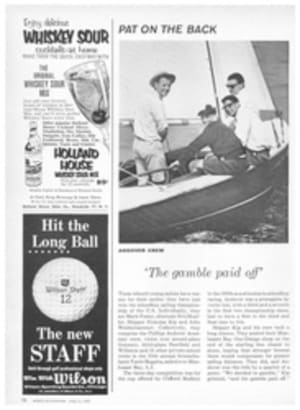
THE ECLIPSE OF MR. K
AT 6:50 p.m. in the green-and-gold setting of an Oregon twilight, the giant Negro in the heavy UCLA sweatshirt raced gracefully across the grass, drew back a shimmering silver javelin and then sent it soaring through the half light of the evening sky.
A hoarse roar rocked the aged structure of the University of Oregon's Hayward Field. As the javelin stabbed quiveringly into the grass, an announcer's voice sputtered hysterically from the public address system: "Ladies and gentlemen," he shouted, "if that javelin has, as it appears, gone over 230 feet, Rafer Johnson has just broken the world decathlon record of the Russian Vasily Kuznetsov!"
A further roar shook the creaky wooden stands. Down on the field, Rafer Johnson first sped excitedly after his victorious javelin, then abruptly knelt in midfield and said a prayer. When he returned to the officials' mark, his normally stoic face was twisted in an unsuccessful fight against tears.
Thus last week in the college town of Eugene, Ore. one of the most remarkable athletic achievements of history was recorded. Rafer Johnson, out of competition for a year because of an auto accident, entered the Olympic tryout (and National AAU) decathlon competition with misgivings and remained to shatter the world's record by an extraordinary 326 points.
The decathlon, which has been described—inadequately—as "grueling" and "exhausting," is a 10-event nightmare that demands of the athlete speed, strength, coordination, endurance and pluck.
It is possible to win a decathlon without finishing first in a single event. The opponent is the clock or the tape measure and oneself, and the best over-all results determine the ultimate winner, the best man. The neat balance of events—sprinting, hurdling, distance running; broad jumping, high jumping, pole vaulting; discus, shotput and javelin—produces in its finest practitioner the indisputable world champion athlete. After his performance last weekend Rafer Johnson is surely that.
He won the hundred meters, won the discus, won the javelin, won the shotput and pressed the winners of every other event, except the 1,500-meter run. If he had finished only third, he would have been assured of a berth on the Olympic team and a trip to Rome, where he would meet his old rival Kuznetsov again. No one would have blamed him for playing it safe and being content just to make the Olympic squad. But Johnson went roaring after the world's record from the start, in reckless disregard of the muscle pulls, cramps and assorted miseries which almost necessarily accompany such a concentrate of competition.
Almost overlooked in the general astonishment at Johnson's achievement was the dogged performance of the Formosan athlete, Yang Chuankwang, whose Chinese name has been Americanized to C.K. Yang. An immensely capable decathlon competitor, Yang needed to run 1,500 meters in 4:34.8 at the end of the two-day contest to beat Johnson. His muscles drawn tight as violin strings after nine events, Yang managed only a 5:09.3, which left him clutching his thighs in a contortion of pain at the finish. He placed second, 257 points behind Johnson, but 69 points ahead of the Kuznetsov world record. It was quite clear that Yang, a student at UCLA who came to the U.S. two years ago knowing only one word of English (beefsteak), is a classic decathloner who may be more of a threat to Rafer at Rome than the Russian. But despite Yang, Rafer Johnson's chief rival at Eugene was Vasily Kuznetsov, or, at any rate, his world record. The shadow of Mr. K was as real at Eugene as the athletes who were there in the flesh.
It was conceded that the winner of the meet would come from the trio of Johnson, Yang or Oregon's Dave Edstrom, runner-up to Yang in last year's nationals. But Memphis' Phil Mulkey, thanks to a superb performance in the pole vault, slipped past Edstrom—who was hampered by a groin injury—to finish third. New York's Mike Herman, who eventually finished sixth, missed out only because of a dismal failure in the javelin and a virtual scratch in the 1,500, which he officially entered but did not run because of a leg cramp. Johnson, Mulkey and Edstrom, the first three American finishers, became the U.S. Olympic entry.
The decathlon is an orgy of interrelated statistics, as complicated in its way as the quantum theory. Every performance in each of the 10 events is measured against a basic standard, and points are awarded in proportion to how closely the athlete approaches (or surpasses) that standard. Ideally, an athlete would average 1,000 points per event for a grand total of 10,000. Perhaps someday someone will actually do that. But Johnson himself, not a boastful man, declared last weekend, "It will be a long time before anyone beats this record."
It will be a long time for two reasons. For one, it probably will be a long time before anyone combines the strength and size of Rafer Johnson with his speed. For another, it will be a long time before decathloners find a broad-jump runway and pit to match the one that the University of Oregon's coach, Bill Bower-man, constructed for this decathlon meet.
Designed by Bowerman and built with his own funds ($600), the broad-jump runway is four feet wide and 160 feet long. Both the runway and the pit are raised one foot above the level of the ground. Built of wood, the runway is topped by a composition of rubber and asphalt. The runway and pit are also used for the pole vault.
Before the decathlon, Bowerman had been concerned because no one ever had managed to jump more than 25 feet on the old existing runway, which headed into Eugene's strong and prevailing northwesterly winds. The pit, moreover, was at the north end of the field, extremely poor from a spectator point of view. He decided this would be a depressing target for the national decathlon stars. He built his new one, headed south and parallel to the stands, with the distances (23 feet, 24 feet, 25 feet, etc.) marked on the board sides of the pit.
The decathloners had a field day on it. Mike Herman almost jumped right onto the Olympic team with a tremendous 26 feet, three inches. More important, Rafer Johnson, who had not dared trust his aching back in the jolting broad jump in practice and who had tried the event only three times in the past year and a half, jumped 24 feet, 9¼ inches to earn 986 points. Dave Edstrom, despite his groin injury, posted his all-time best of 24 feet, 3 inches and, content with that, skipped his last two jumps.
Bowerman plans to lengthen the pit for the broad jumpers who will be on hand when the Olympic team goes into training at Eugene later this month. He is afraid 27 feet may not be long enough and that Jesse Owens' world record of 26 feet, 8¼ inches, which has stood since 1935, may be broken.
Rafer Johnson grinned mischievously when asked about the Bowerman runway. "There's no doubt you get a take-off," he said on the first day of competition, before even his admirers had begun to reckon on a record. The next day Rafer soft-pedaled his views, allowing that his high jump (which was on the existing pit, not noticeably conducive to exceptional scoring) was what had really put him into his world record orbit.
Johnson was in the enviable position of having broken the world record after only nine events. In the final, lung-searing 1,500 (which he hates, moaning "It's ridiculous") Rafer had only to jog around in anything better than the minimal time of 5:50 to pad his record. He did 5:09.9 to pick up a respectable 202 points.
It is hard to imagine an event that can chew a man up physically as much as the decathlon. Most of the entrants spent equal amounts of time on the training table, under the heat machines or in exhausted sleep. "The second day is the worst because it's the second day," said Rafer. "You are too tired to walk, yet you got to run."
Toward the end of that tiring second day Rafer's elation at his new record was tinged with suspense. His friend, Yang, with whom he works out at UCLA between meets, was only a few hundred points behind Johnson when he took his mark for the 1,500. Yang had run the event previously in better than 4:35—as he would have had to do to defeat Rafer—but never in a decathlon. Indeed, it is questionable whether Herb Elliott could better five minutes after spending two days running dashes and hurdles, jumping, vaulting, throwing weights. Still, Rafer was worried and turned aside the reassurances of his friends. Yet when Yang tied up on the first quarter and almost fell, Rafer, forgetting his record, ran to his side. He virtually trotted the rest of the race, exhorting Yang to keep going.
It will be a long time before track fans—or the fans of any sport—can reasonably expect to see another athlete of the magnificence, in every way, of Rafer Johnson.
PHOTO
MUSCLES STRAINING, burly Rafer Johnson breaks tape in decathlon 100-meter dash.
PHOTO
RUNNER-UP TO JOHNSON WAS C. K. YANG OF FORMOSA
ELEVEN ILLUSTRATIONS
ROBERT RIGER
THE MAN RAFER HAS TO BEAT AT ROME
RAFER'S RED RIVAL
These drawings show Vastly Kuznetsov, the Russian champion, in each of the 10 decathlon events. Kuznetsov uses six types of track shoe (one is shown at left).
CLOCKS AND TAPES
These marks are those recorded by Kuznetsov and Johnson as they set their world records. But each has done better in all 10 events separately at other times.
ATTRITION
Weariness attacks on the second day, especially after the demanding pole vault. When the last event, the 1,500, begins, the athletes are near exhaustion.
VASILY'S VERSATILITY
Most decathlon men are especially strong in one or two events and not so good in the others. But Kuznetsov, like Rafer Johnson, is outstanding in nine of the 10 events (the 1,500 meters is a weak spot for everyone).
100-METER DASH | BROAD JUMP | SHOTPUT | HIGH JUMP | 400-METER RUN | 100-METER HURDLES | DISCUS THROW | POLE VAULT | JAVELIN THROW | 1,500-METER RUN | |
KUZNETSOV | 10.7 SECONDS | 24 FEET 1¼ | 48 FEET 2 | 6 FEET 2 ½ | 49.2 SECONDS | 14.7 SECONDS | 163 FEET 10¼ | 13 FEET 9‚Öú | 213 FEET 5½ | 5:04.6 |
JOHNSON | 10.6 SECONDS | 24 FEET 9¼ | 52 FEET | 5 FEET 10 | 48.6 SECONDS | 14.5 SECONDS | 170 FEET 6½ | 13 FEET ¼ | 233 FEET 3 | 5:09.9 |

